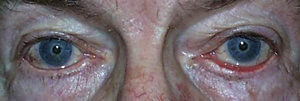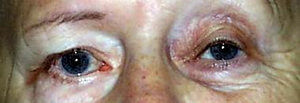![]()
Tampa
(813) 971-3846
![]()
Tampa
(813) 971-3846
Ectropion is the medical term used to describe sagging and outward turning of the lower eyelid and eyelashes. The margin of the eyelid and the eyelashes evert (turn out). During blinking, the eyelids normally sweep across the surface of the cornea. Tearing occurs because the eyelids are not able to wipe the surface of the cornea properly to pump the tears into the tear duct. This can result in drying of the cornea from exposure. Congenital ectropion is caused by a shortage of eyelid skin present at birth.
 Cicatricial ectropion is the pulling of the upper or lower eyelid away from the eye because of scar formation or a shortage of skin of the eyelid. Cicatricial ectropion can occur as a result of aging skin changes, sun damage and chronic dermatitis. Mechanical injuries such as lacerations and burns – thermal, chemical and radiation can cause scarring resulting in ectropion. Previous eyelid surgery such as blepharoplasty or tumor removal can result in ectropion due to removal of too much skin. It can also be seen after ptosis surgery, entropion repair and orbital surgery, such as orbital fracture repair. Infections such as herpes zoster (shingles) can cause contraction and ectropion of the eyelid.
Cicatricial ectropion is the pulling of the upper or lower eyelid away from the eye because of scar formation or a shortage of skin of the eyelid. Cicatricial ectropion can occur as a result of aging skin changes, sun damage and chronic dermatitis. Mechanical injuries such as lacerations and burns – thermal, chemical and radiation can cause scarring resulting in ectropion. Previous eyelid surgery such as blepharoplasty or tumor removal can result in ectropion due to removal of too much skin. It can also be seen after ptosis surgery, entropion repair and orbital surgery, such as orbital fracture repair. Infections such as herpes zoster (shingles) can cause contraction and ectropion of the eyelid.
 Most cases of ectropion are due to relaxation of the tissues of the eyelid as a result of the aging process. Some cases result from scarring of the eyelid caused by chemical and thermal burns, trauma, skin cancers, or previous eyelid surgery. Rarely ectropion can be present at birth if the eyelids do not develop properly. Ectropion should be repaired surgically before the exposure of the cornea causes infection and scarring. Prior to surgery, the eye can be protected by using lubricating drops and ointment. In some cases, sutures can be placed through the lower eyelid until more definitive surgery can be performed. The surgery to repair ectropion is usually performed under local anesthesia as an outpatient. In most cases, the eyelid and its attachments will tighten and a skin graft may be required. You may have a patch overnight and then will commonly use an antibiotic ointment for about a week. After your eyelids heal, your eye will feel comfortable and you will not longer have the risk of corneal scarring, infection, and loss of vision.
Most cases of ectropion are due to relaxation of the tissues of the eyelid as a result of the aging process. Some cases result from scarring of the eyelid caused by chemical and thermal burns, trauma, skin cancers, or previous eyelid surgery. Rarely ectropion can be present at birth if the eyelids do not develop properly. Ectropion should be repaired surgically before the exposure of the cornea causes infection and scarring. Prior to surgery, the eye can be protected by using lubricating drops and ointment. In some cases, sutures can be placed through the lower eyelid until more definitive surgery can be performed. The surgery to repair ectropion is usually performed under local anesthesia as an outpatient. In most cases, the eyelid and its attachments will tighten and a skin graft may be required. You may have a patch overnight and then will commonly use an antibiotic ointment for about a week. After your eyelids heal, your eye will feel comfortable and you will not longer have the risk of corneal scarring, infection, and loss of vision.
 The Facial Nerve is the 7th of the 12 Cranial Nerves. The facial nerve controls the muscles of facial expression, including the frontalis muscle (raises the eyebrows), the orbicularis oculi muscle (closes the eyes), the zygomaticus muscles (raises the angle of the mouth), and the orbicularis oris muscle (closes the mouth). With paralysis or palsy (partial paralysis) of the nerve, the function of these muscles is weakened. Facial nerve palsies may be congenital (present at birth) or acquired. Acquired causes include inflammation (Bell’s Palsy), vascular lesions, tumors (acoustic neuroma, parotid gland or temporal bone tumor) or trauma (birth, temporal bone fracture). Patients with facial nerve palsy develop flattening of the entire face with loss of forehead wrinkles, eyebrow drooping, elevation of the upper eyelid, ptosis (drooping) and ectropion (outturning) of the lower eyelid, epiphora (tearing), lagophthalmos (inability to close the eye), and exposure keratopathy (drying of the cornea).
The Facial Nerve is the 7th of the 12 Cranial Nerves. The facial nerve controls the muscles of facial expression, including the frontalis muscle (raises the eyebrows), the orbicularis oculi muscle (closes the eyes), the zygomaticus muscles (raises the angle of the mouth), and the orbicularis oris muscle (closes the mouth). With paralysis or palsy (partial paralysis) of the nerve, the function of these muscles is weakened. Facial nerve palsies may be congenital (present at birth) or acquired. Acquired causes include inflammation (Bell’s Palsy), vascular lesions, tumors (acoustic neuroma, parotid gland or temporal bone tumor) or trauma (birth, temporal bone fracture). Patients with facial nerve palsy develop flattening of the entire face with loss of forehead wrinkles, eyebrow drooping, elevation of the upper eyelid, ptosis (drooping) and ectropion (outturning) of the lower eyelid, epiphora (tearing), lagophthalmos (inability to close the eye), and exposure keratopathy (drying of the cornea).


Phone: (813) 971-3846
Office Hours:
Mon - Fri: 8am - 5pm
5379 Primrose Lake Cir
Tampa, FL 33647
(Inside the office of The Bowman Institute for Dermatologic Surgery)
Phone: (813) 971-3846
©Copyright 2015 J. Justin Eyelid Institute All Rights Reserved.